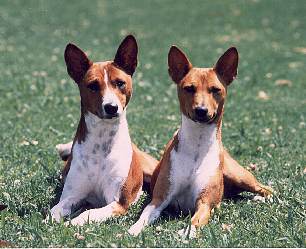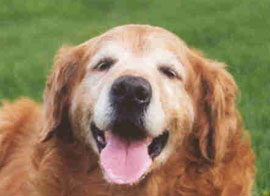Please Help Homeless Pets with a donation of one dollar

Natural and Alternative Treatments for Noise Phobic Dogs
By: Tippy
Some people like to pursue a more natural alternative
treatment that doesn't include medication for their phobic
dog. These therapies have met with some success and really
it depends on the preference of the owner and the tolerance
of the dog.
Such natural alternatives include aromatherapy with flower
essences like Rescue Remedy, and melatonin. These
alternative treatments have been shown to take effect within
an hour of administration to the dog. They should be given
to your dog an hour before a storm or noisy event.
Changing your Dogs Environment:
It has been shown that moving your dog to a room that is
more soundproof has an effect of reducing its anxiety from
noise phobia. This makes your dog less aware of the storm,
fireworks, street work or other loud sounds, of course.
You should also increase the level of activity that your dog
gets during the day. If you give your dog a lot of exercise
every day and especially on days that a storm is predicted
it makes it tired physically and mentally, which makes your
dog less likely to have such a dramatic response to storm
activity or noise.
Exercise also increases the level of serotonin in the body
which acts as a natural sedative. This bit of advice should
definitely be followed if you have a dog that is a working
dog or sporting dog breed, these breeds naturally has a lot
of energy because they were bred to have it. Dogs that are
especially nervous will benefit as well.
You can also block or reduce the noise level by what is
typically called white noise therapy. You increase a noise
that doesn't trigger a fear response, such as a fan running
or the air conditioner being on. It may help even to leave
the television on loudly or to get a noise maker and let it
run white noise all the time that the storm is going on.
You can also give your pet access to a room that is
naturally noise reducing like the basement or a well-
insulated room in the middle of the house. Be sure to close
windows and curtains during a storm, this helps to insulate
the house so that noise isn't so easy to hear inside the
house. Some dog owners have even used cotton balls or ear
plugs in their pet's ears.
Some dogs like to be crated while a storm is going on. This
simulates a den, which is a protective safe haven that wild
animals make to take shelter when they need to. This can be
a commercial dog crate or a small room like a bathroom. Some
dogs even like to get into a bathtub and stay there for the
duration of a storm, which makes easy clean up for you if
your dog has a tendency to urinate when frightened.
If your dog likes being in a crate then make it comfortable
and as well insulated as possible. Put a
dog bed in the
crate, or blankets, then cover the crate with a blanket. You
can then run a white noise maker next to the crate to help
drown out the noise of the storm.
Be sure to leave the door to the crate open so that the dog
doesn't feel like it is being confined just that it is in a
safe place. Some dogs react negatively to being locked into
a crate and this will make the stress worse for them.
And remember that you are the leader of the pack. If you are
calm that will translate to the dog and make it feel calmer.
If you are afraid of storms as well then the worst thing you
can do is to get hysterical along with your dog. This makes
it even more stressful for your dog. Be calm, in charge and
upbeat while a storm is going on and your dog will take your
lead and not get so scared.
You should also make sure that your dog has a healthy diet
and good nutrition. If a dog doesn't have proper nutrition
in its diet it will increase the stress level of the pet and
thereby increase its anxiety. Diet has a dramatic effect on
whether you or your dog feels good or not.
If your dog is ill or in pain this will increase its
anxiety. If you want to change your pet's diet to try to
help, ask your veterinarian for suggestions. Note that some
dogs do not take well to changes in diet and this can cause
constipation or diarrhea alternately until they get used to
the new food.

You can also try behavior modification - special techniques
that try to change the animal's response to noise.
One such method is called counterconditioning.
Counterconditioning is a technique in which the animal is
taught a behavior that is acceptable to replace a bad
response to stimulus. In this way the trigger or negative
stimulus becomes associated with a good thing rather than a
cause of fear.
You can start doing this by doing something, giving
something that is your dog's favorite thing. For instance if
your dog loves a certain squeaky toy only give it to it
prior to a storm. If your dog loves a particular treat give
it the treat before a thunder storm. If your dog really
likes car rides then take it for a spin before a storm.
Warning: if your dog likes to swim only let it go swimming
after a storm. Over time the dog will associate the storm
with its favorite thing.
Another behavior modification method that is commonly used
is called desensitization. Desensitization is done by
decreasing the level of your dog's response to the stimulus
by exposing it to something similar that it can learn not to
fear. Thereby your dog is taught to be calm when a similar
noise is present. You do this by getting a tape of the noise
that the dog is afraid of and running it at a low level,
gradually increasing the sound as the dog adjusts.
Be sure to test the tape and be sure that it engenders a
fear response or the recording won't work. If it doesn't
frighten the dog then it may be the combination of events
that occur during a storm that makes your dog afraid,
including: barometric pressures, lightning, wind, rain, and
etcetera.
For animals that only react to the combination of events,
get a strobe light to simulate lightning. A storm soundtrack
and darkening the room may get the response you want. You
don't want to torture your dog; you just want to mimic the
storm as closely as you can so that you can start the
desensitization process.
Start by playing the tape at a low level that your dog can
hear and that gets the dog's attention, but not so high that
it frightens the dog. Depending on how much of a phobia your
dog has you may need to play the tape in another room away
from your dog. Then you want to keep the dog's attention by
doing obedience training exercises or other mental
activities that takes the dog's mind off of the noise.
Reward your dog when it successfully performs a trick or a
command under these circumstances.
If the dog starts to get upset stop and try again another
day, but play the tape at a lower sound level. You do not
want to reward your dog when it starts exhibiting fear
symptoms, this can undo the desensitization process. The
desensitization process sessions should go on for about
twenty minutes at a time.
If your dog doesn't get frightened at the tape then increase
the sound of the tape a little for your next session. Repeat
the same process of engaging your dog mentally. Then do the
same next session and the next. If your dog starts to show
fear decrease the sound, and if there is no fear present
increase the sound.
You should also do this in different rooms of your home and
with different people around so that your dog doesn't become
attached to you, time or day, the room and the events going
on and that is the only way your dog will feel comfortable
if a storm is happening.

If your dog doesn't show fear when the tape is being played
loud then try leaving the room so that it is only your dog
in that room alone. Do this for only a short time and
gradually increase the time you are away from your dog over
the next few sessions if no fear is present.
You need to be consistent with noise desentization. When
your dog starts to show signs of no longer having the fear
then you can decrease the sessions to once a week instead of
every day. Some people have found that these sessions will
have to be repeated once a week for the rest of the dog's
life so that the fear will not come back.
When a storm is going on use the same tactics you used while
doing the desensitization process. You should do the
desensitization process when it isn't the stormy season in
your area or when noisy celebrations will be taking place
like the Fourth of July or New Year.
It's best to take you dog off of any behavior-modifying
drugs when doing the desensitizing process. And be sure to
notify your veterinarian before doing this and/or taking
your pet off of any medicines that your dog may be taking.
Thunderstorms are a very common fear trigger in dogs. But
noise phobia can be reduced with treatment and by changing
habits and behaviors. Remember, do not give your dog any
kind of preferential treatment when it is exhibiting fear,
this only reinforces the behavior and makes the situation
and its cure harder on your pet.
See also:
Mellow
Out Natural Dog Relaxant (helps your pet deal with stress & noise)
How to help your Dog
live a Longer Life